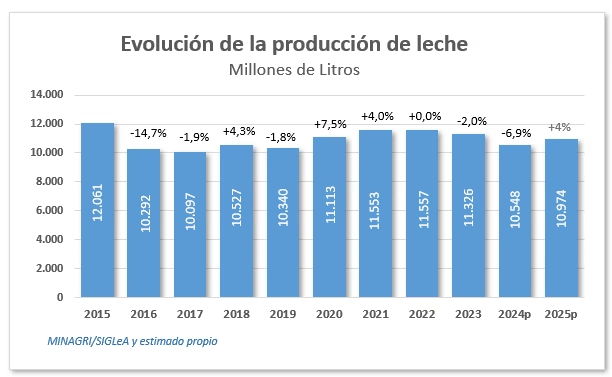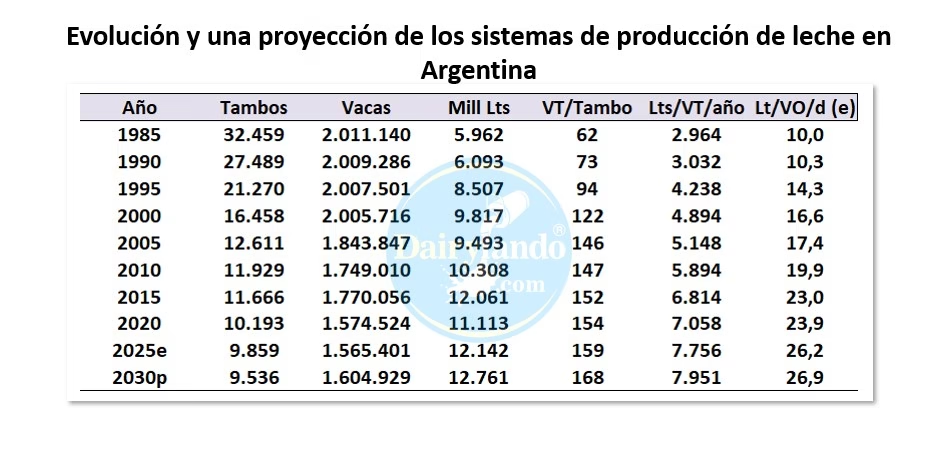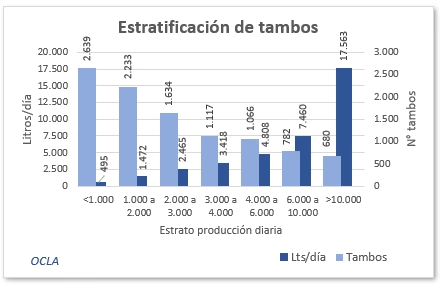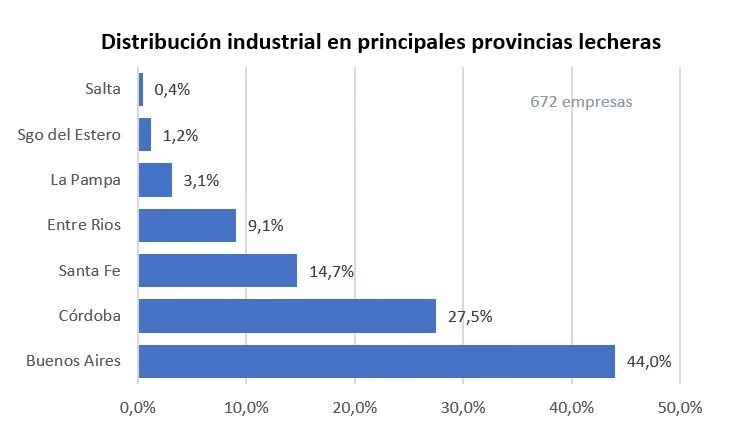Argentinian dairy and its actors.
El año 2015, con 12.061 millones de litros, marcó la mayor producción de leche en Argentina. Debido a la crisis, la misma cayó -14,7% en su producción de leche durante el año 2016 y otro -1.9% menos en 2017 tocando fondo. Lentamente se va recuperando la leche perdida ralentizado por un menor número de vacas en el rodeo nacional. El año 2024 cerró con -7,0% con respecto al 2023 para totalizar 10.546 millones de litros. Argentina pierde su lugar como 3ra exportadora de leche en polvo entera a manos de Uruguay. De ése volumen se consume unos 8.050 mill lts (a razón de 170 equivalente litros/cápita), quedando un remanente exportable de 2.500 mill de lts (55 litros/cápita).

In the following table we can observe the evolution of systems of milk production in Argentina, an estimate for 2021 and a projection for 2030:

The sector generated a net value of $6801,71 million in 2021 (IAPUCo) and represent a level of direct and indirect employment of 187,000 direct jobs positions, with primary production by providing 42,800 and the industrial sector 33,125 direct jobs (FUNPEL, 2022).
While the interventions of the National Government in the milk market in recent years have seriously affected the sector, the current situation (as of December 2015) has changed and is expected to, once we overcome the crisis in which it is immersed dairy all (national and international) that Argentina could capitalize on the potential inherent in its resources, for when the conditions of the external market conditions are favorable.
The limitations to the sustained growth of the dairy argentina recognize, on the one hand, factors-macroeconomic and, on the other, the inherent problems of the chain. Obviously, both planes are related.
We have to make transparent the management of the price of the milk, as well as the information linked to the general operative of the Dairy Chain. Also generate an economic environment with rules of the game clear and legal security assured that allows them to attract investment and to facilitate adoption of the technology in the primary production and industrial means of enhancing the growth of the production and guarantee the increase of the volumes exported. On the other hand we must free the trade of dairy products in both the domestic and external market, to implement the automatic refund of the IVA export and to support that activity with pre-financing export, stock financing and credits to reduced rate for industrial investments and/or the production sector.
-Concentration of the primary sector of production
The process of concentration that is observed in the world also occurs in Argentina, where the 40,000 dairy farms that existed in the decade of the sixties, we find that at present it is estimated around 10,000 commercial dairy farms. In the following chart we can see the distribution of those drums for daily milk production (OCLA, December 2023):

-Geographical distribution of the drums and the rodeo dairy
SENASA December 2021

-Scale of the drums by province
SENASA, March 2017
- Major companies producing milk of Argentina (Survey TODOAGRO 2018)

-Possession of the earth

— Description of the sector of the dairy industry
There are in Argentina 670 industries, milk processing enabled that feature 36,000 employees (AFIP 2013), of which 450 buy milk to third parties. The largest are located in Buenos Aires and Santa Fé:

-Main processing industries:
There are in Argentina 670 industries, milk processing enabled that feature 36,000 employees (AFIP 2013), the larger are located in Buenos Aires and Santa Fe. In the following list the first 50 industries in receipt of milk:

– Profile of the dairy industry national
Summary of the survey on a national scale made by MINAGRI with the provincial governments totaling 670 dairies in the country:

-Destinations of the raw milk

Own elaboration with data from MINAGRI
@dairylando

I would like to know which is the source of data with which they built the Ranking of Plants Milk for Receipt of Milk?
Many thanks for the report, very good information.
Greetings,
Nicholas
Hi Nicholas, that information with list of plants and their receipt journal was published in the magazine Infortambo in 2014. It was more a complete list of their own that I will be updating from what was published by Azpiazu, Gutman and Vispo in "The deregulation of the Markets," march 1999.
Thank you!
should not the Siglea or Funpel issue monthly this statistical Ranking of dairy companies ?? at least the milk formal?
Gustavo, that info the SIGLeA have but under statistical secrecy.
Good afternoon, sorry for the ignorance, I would like to know who and how the price of milk.
Many thanks
Hi Peter, it is a question wide!. The argentine industry is arming the price paid to the producer is currently 80% by composition and quality hygienic-sanitary and a 20% bonus trade (some of them tabulables and others not). The SIGLeA gathers information about 8,400 of payouts made each month and publishes the average price and the pictures opening up a little bit of the information that is published on the Command Board of the Minagri. Among the claims of the production is to make a reduction of bonuses commercial and limiting them to those tabulables and a discrimination of the freight of the raw material, among other things.
Hello, do you know how much investment has been made in the industry of processing of dairy products in 2017 and 2018? Many thanks.
This info does not have it...difficult years to invest...now if you are making considerable investments in the industrial sector both in Córdoba and Santa Fé and Buenos Aires...but we don't have the amounts
Thanks for your reply,
After some research, I would say that are a little more than a Thousand million ARS in 2017 and 2018.
Do you know if there are figures on the debt of the dairy farms (for example, $/cow) ? Thank you.
We estimate a level of debt (bank+commercial) of about 800 US$/cow
Thank you.
Hello how are you m, you can help with this question I can't find it
What are the social actors in the dairy production?
The social actors are all q interact according to the interest activity-specific, in this case: the dairy chain. Then I would include every character involved in the cluster dairy, dairy farmers, veterinarians, agronomists , suppliers, production and industry, carriers, and employees in factory processing, etc
Hello ! Go to the page of COTAR (Cooperative of dairy farmers of Rosario), a firm's flagship was the first plant milk of South america (1963), which reports that processes 8 million liters of gasoline a month (about 260mil liters per day).
Why is not listed in any ranking of processors of milk ?
Hi Ricardo, thanks for your note thanks to her we update rankings 2020..there figure COTAR with your receipt manifested the past years to the people of TODOAGRO on the other hand I commented that there were plants milk since the early 1900's in Argentina, and there are currently functioning founded in 1931
Concerning the Description of the sector of the dairy industry is up-to-date information to you ?. And that source is?.
...if Juan Manuel... is the latest information available for the industrial sector
As they are called social actors of the circuit dairy??
the social actors of a string are the people that have a role within the same that brings to its development...the tambero, the academic, the technician, truck driver, etc
Hi I would like to know if you have any information about the drums of villarino ,inta?
You referias to the number of drums that are in Villarino? That there are q look for it in SENASA
According to the records of GOVERNMENT in 2020 to Villarino had 7 dairy farms with 14 drums and a total of 5.634 dairy cows. In other locations we have observed a reduction of this info between 25% and 30% in the number of dairy farms
https://www.argentina.gob.ar/files/existenciasbovinasentambospordepartamentomarzo2020xlsx